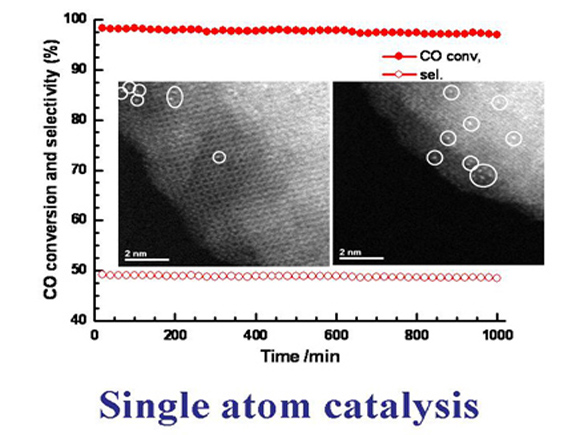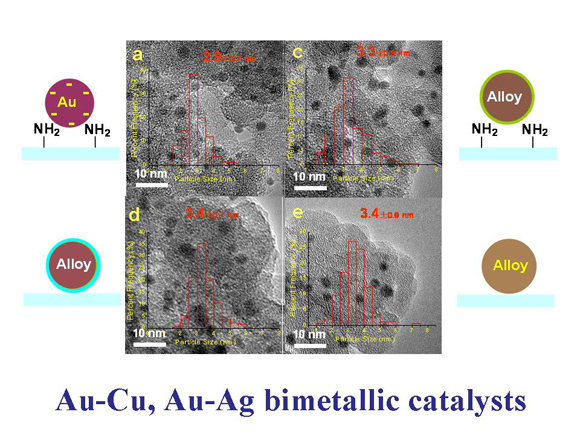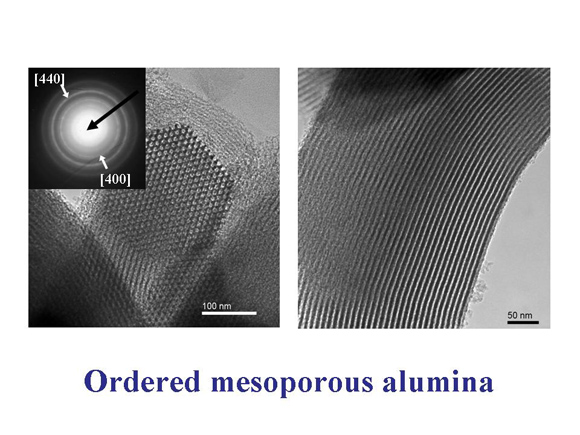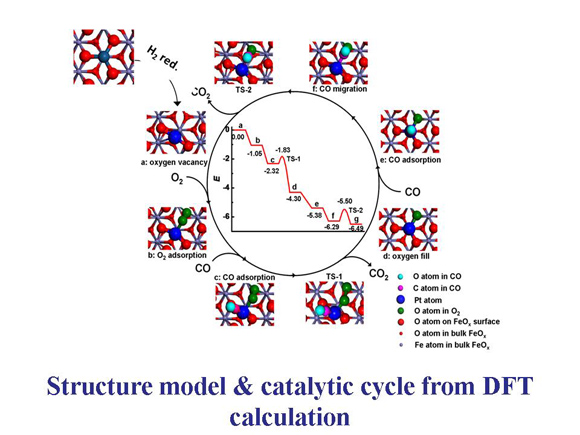Design and synthesis of nano- and subnano catalytic materials
Supported metal catalysts are widely used in catalytic conversion reactions. A better control of the nature of the solids used as catalysts translates into a better control of their catalytic activity, selectivity, and stability. Our group focuses on development of new support materials and new synthesis methods to obtain well-dispersed and homogeneously distributed metal catalysts.
Current research projects include:
☆ Single atom catalysis
Dispersing noble metals as isolated single atoms on a metal oxide support is the long-awaited dream of catalysis, which may lead to low-cost industrial catalysts and address questions in fundamental catalytic science. Developed in 2011 by a collaborative team led by Prof. Tao Zhang, Prof. Jun Li, and Prof. Jingyue Liu, the first single atom catalyst Pt1/FeOx was successfully prepared by a wet-chemistry method, which is highly active for both CO oxidation and preferential oxidation of CO and keeps stable during the reaction.

☆ Design and synthesis of bimetallic catalysts
Bimetallic catalysts have replaced many monometallic catalysts for a wide range of catalytic applications, due to their enhanced selectivity, stability, and/or activity relative to their corresponding monometallic components. Several families of bimetallic catalysts have been developed in our group including Au-M (Ag, Cu, and Pd), and Ni-NM (Pt, Ir, Rh)( Chem. Commun. 2008, 3187-3189).

☆ Synthesis of mesoporous materials as catalyst carriers
Mesoporous materials are amongst the most promising candidates to be used as catalyst carriers due to their unique nano-architectures. We successfully designed series of mesoporous alumina, carbon, heteroatom doped mesoporous carbon, and cabon-alumina nanocomposites. High-efficiency porous heterogeneous catalysts were produced on the basis of the synthegetic effect of the high surface area, uniform pore channel, and the reactivity.

☆ In situ characterization & DFT calculation
Catalytic mechanism is the key to understand the reaction process and to design high efficient catalyst in heterogeneous catalysis. We managed to develop several in situ techniques, including Microcalormeter, Mössbauer, Raman, Infrared, to utilize in characterization of the catalyst surface structure, the catalytic mechanism. Moreover, quantum mechanic based calculation, especially the density functional theory (DFT) calculation was also performed in our group.

Associated research fellow: Prof. Aiqin Wang, Dr. Lin Li, Dr. Yanqiang Huang, Dr. Botao Qiao, Dr. Xiaofeng Yang.
Recent publications:
1. Design of a Highly Active Ir/Fe(OH)x Catalyst: Versatile Application of Pt-Group Metals for the Preferential Oxidation of Carbon Monoxide Jian Lin, Botao Qiao, Jingyue Liu, Yanqiang Huang, Aiqin Wang, Lin Li, Wansheng Zhang, Lawrence F. Allard, Xiaodong Wang*, Tao Zhang* Angew. Chem. Int. Ed., in press.
2. Single-atom Catalysis of CO Oxidation using Pt1/FeOx Botao Qiao, Aiqin Wang, Xiaofeng Yang, Lawrence F. Allard, Zheng Jiang, Yitao Cui, Jingyue Liu*, Jun Li*, Tao Zhang* Nat. Chem., 3 (2011) 634-641.
3. Synthesis, Characterization, and Catalytic Application of Highly Ordered Mesoporous Alumina-Carbon Nanocomposites Jinming Xu, Aiqin Wang, Xiaodong Wang, Dangsheng Su, Tao Zhang* Nano Research, 4(1)(2011)50-60.
4. Synthesis of Thermally Stable and Highly Active Bimetallic Au-Ag Nanoparticles on Inert Supports Xiaoyan Liu, Aiqin Wang, Xiaofeng Yang, Tao Zhang*, Chung-Yuan Mou, Dangsheng Su, Jun Li Chem. Mat., 21 (2009) 410-418 (Cover article).
